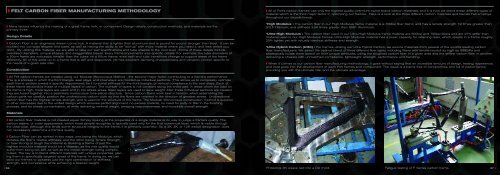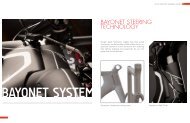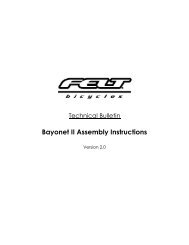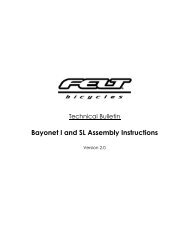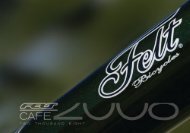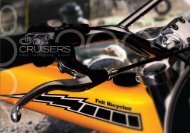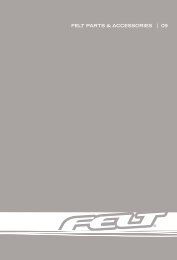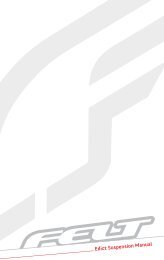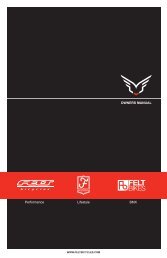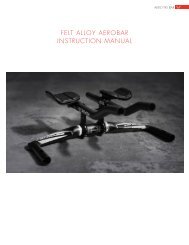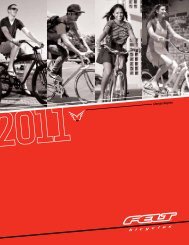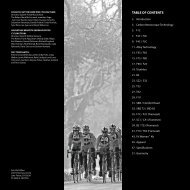You also want an ePaper? Increase the reach of your titles
YUMPU automatically turns print PDFs into web optimized ePapers that Google loves.
❚ Many factors influence the making of a great frame, fork, or component. Design details, construction methods, and materials are the<br />
primary three.<br />
Design Details<br />
❚ Carbon Fiber is an engineers dream come true: A material that is lighter than aluminum and is pound for pound stronger than steel. It can be<br />
molded into complex shapes and sizes, as well as having the ability to be "laid-up" with more material where you need it, and less where you<br />
don’t. By utilizing this material, we are able to take our wall specifications and tube shapes to the next level. Some of these details include<br />
oversized diameters, unique shapes, and exaggerated tapers. Every frame implements size-specific details. For example: the tube diameters of<br />
a 50cm frame are noticeably smaller than the tubes on a 60cm frame; even radii and tube transitions change to support areas of the frame<br />
differently. All of this adds up to a frame that is stiff and responsive, yet has excellent damping characteristics and vibration control, specific to<br />
the needs of a given size rider.<br />
Construction<br />
❚ All <strong>Felt</strong> carbon frames are created using our Modular Monocoque Method - the second major factor contributing to a frame’s performance.<br />
This is a process in which the front triangle, seat stays, and chainstays are molded as individual sections. This allows us to completely optimize<br />
each frame section toward a specific requirement; be it torsional stiffness for the front triangle, or vertical compliance in the seat stays. Each of<br />
these frame sections is made of multiple layers of carbon. The number of layers is not constant along the entire part: in areas where the load on<br />
the frame is high, more layers are used; and in low stress areas, fewer layers are used to save weight. After these individual sections are created,<br />
they are fused together into a seamless monocoque (one-piece) structure. Since carbon fibers work best in tension, when assembling the<br />
carbon parts we carefully position the unidirectional carbon cloth so that the fibers are oriented in the direction of greatest stress. Unidirectional<br />
carbon fiber has the highest tensile strength, and is used for the structure of the frame. The Modular Monocoque construction method is superior<br />
to other processes due to the unified design which ensures perfect alignment, no excess material, no need for putty or filler in the finishing<br />
process, and no stress concentration; all while delivering minimal weight, amazing responsiveness, and incredible overall strength.<br />
Materials<br />
❚ All carbon fiber material is not created equal. Simply looking at the properties of a single material is no way to judge a frame’s quality. The<br />
carbon weave, or outer appearance, which most people recognize is typically used only for the final outermost layer, which is visible through<br />
the clear coat. Although this lends some structural integrity to the frame, it is primarily cosmetic. So a 2K, 3K, or 12K weave designation does<br />
not necessarily determine a frame’s quality.<br />
❚ Carbon Fiber can be ranked in two ways: one being the Modulus, which<br />
dictates the fiber’s relative stiffness; and the other being Tensile Strength,<br />
or how strong or tough the material is. Building a frame of just the<br />
highest modulus material would be a disaster, as the ride quality would<br />
suffer from being too stiff, as well as the overall strength being compromised.<br />
The key is to blend different materials with unique properties, placing<br />
them in specifically targeted areas of the frame. In doing so, we can<br />
tailor our frames to possess just the right combination of stiffness,<br />
strength, and compliance while achieving a desired weight.<br />
❚ 06<br />
FELT CARBON FIBER MANUFACTURING METHODOLOGY<br />
❚ All of <strong>Felt</strong>’s carbon frames use only the highest quality, premium name brand carbon materials, and it is how we blend these different types of<br />
material which is the third major factor in optimizing our frames. Here is a look at the three different carbon materials and blends <strong>Felt</strong> employs<br />
throughout our bicycle lineup:<br />
*High Modulus : The carbon fiber in our High-Modulus frame material is a 700ksi fiber blend, and has a tensile strength 7.9 times greater than<br />
3/2.5 Titanium, and stiffness 3.34 times greater than 6061 Aluminum.<br />
*Ultra-High Modulus : The carbon fiber used in our Ultra-High Modulus frame material are 800ksi and 700ksi fibers and are 27% stiffer than<br />
material used in our High Modulus frames. Ultra-High Modulus material has a lower capacity for retaining resin, which results in a frame roughly<br />
20% lighter, yet with virtually identical stiffness and strength.<br />
*Ultra Hybrid Carbon (UHC) : For frames utilizing our Ultra Hybrid Carbon, we source materials from several of the world’s leading carbon<br />
fiber manufacturers. We select the optimal blend of three different fiber types including fibers with tensile moduli as high as 588GPa and<br />
strategically locate them based on their unique attributes; using the toughest carbon fiber in a given area and the stiffest carbon fiber in another,<br />
delivering a chassis with unmatched compliance, lightweight, strength, performance and handling.<br />
❚ When it comes to our carbon fiber manufacturing methodology, it goes without saying that an incredible amount of design, testing, experience,<br />
and cost goes into the development of each <strong>Felt</strong> frames and component. The result is a frame free of compromise and full of performance;<br />
providing you with the ultimate ride, and the ultimate advantage.<br />
Protective 3K weave laid into a DA mold. Fatigue testing of F Series carbon frame. 07 ❚


